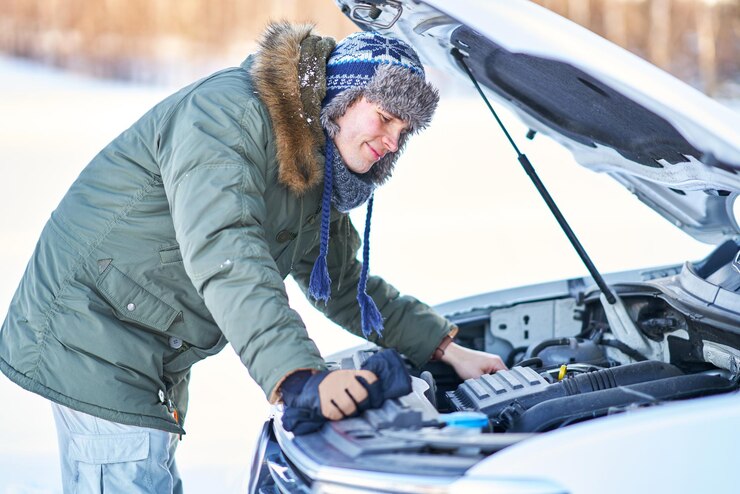Check Engine Cold Weather: What You Need to Know
As winter approaches, car owners often worry about how low temperatures can affect their vehicles. The check engine light, a vital indicator of potential issues within your car’s engine, can become particularly relevant in cold weather. Understanding the relationship between cold temperatures and engine performance can help you take proactive measures to avoid costly repairs and ensure your vehicle runs smoothly throughout the winter months.
How Cold Weather Affects Engine Performance
When temperatures drop, several factors can impact your engine’s performance, including oil viscosity, battery efficiency, and fuel vaporization. Each of these factors plays a crucial role in how well your engine starts and operates in cold weather.
Oil Viscosity and Flow
Engine oil is crucial for lubricating the moving parts of your engine. In cold weather, oil can thicken, making it more challenging for the engine to pump it through the system. Thicker oil means less lubrication, which can lead to increased friction and wear on engine components. This is why it’s essential to use the right oil viscosity for winter conditions; many manufacturers recommend switching to a lighter oil during the colder months to improve flow and reduce engine strain.
Battery Performance
Cold weather can significantly affect your vehicle’s battery performance. At lower temperatures, a battery’s capacity to hold a charge diminishes, which can lead to difficulty starting the engine. If your battery is older or not in good condition, it may fail entirely in frigid conditions. Regularly checking your battery’s health and ensuring it’s fully charged can prevent unexpected breakdowns during the winter months.
Fuel Vaporization
In cold weather, gasoline can become denser and less volatile, making it more challenging for the engine to vaporize fuel for combustion. This can result in rough idling, reduced power, and difficulty starting the engine. Using winter-blend fuel, which is formulated to perform better in lower temperatures, can help mitigate these issues.
The Importance of Regular Maintenance
Regular vehicle maintenance is critical to ensure your engine operates smoothly, especially during the winter months. Here are some essential maintenance tasks to consider:
Check Your Engine Oil
As mentioned earlier, using the right oil viscosity for cold weather is essential. Make sure to check your owner’s manual for recommendations and consider switching to synthetic oil if you haven’t already. Synthetic oils tend to perform better in extreme temperatures, both hot and cold.
Inspect the Battery
Before the winter season begins, have your battery tested for charge and health. If your battery is more than three years old, consider replacing it, as older batteries are more prone to failure in cold weather.
Examine the Cooling System
Your vehicle’s cooling system is crucial for regulating engine temperature. Ensure that the coolant level is adequate and that the coolant itself is in good condition. Flushing the cooling system and replacing old coolant can help prevent freezing and engine damage.
Check Belts and Hoses
Cold weather can cause rubber components, such as belts and hoses, to become brittle and crack. Inspect these parts for signs of wear and replace any that show signs of deterioration to prevent breakdowns.
Tire Maintenance
Proper tire maintenance is vital for winter driving safety. Cold weather can reduce tire pressure, leading to poor handling and increased tire wear. Regularly check your tire pressure and tread depth, and consider switching to winter tires for improved traction on icy or snowy roads.
What to Do If Your Check Engine Light Comes On
If your check engine light illuminates during the cold weather, it’s essential not to ignore it. Here’s a step-by-step guide on what to do next:
Check for Obvious Issues
Before heading to a mechanic, do a quick inspection of your vehicle. Look for any visible signs of trouble, such as fluid leaks or unusual smells. Make sure the gas cap is tight, as a loose cap can trigger the check engine light.
Use an OBD-II Scanner
If you have access to an OBD-II scanner, you can retrieve the trouble codes from your vehicle’s computer. These codes can give you insight into what might be causing the check engine light to activate. However, interpreting these codes requires some automotive knowledge, so it may be best to consult a professional.
Visit a Mechanic
If you cannot determine the cause of the check engine light or if it remains on after addressing any obvious issues, it’s time to take your vehicle to a mechanic. They can perform a more thorough diagnostic and address any problems before they escalate into more significant issues.
Preparing Your Vehicle for Cold Weather
Taking proactive measures to prepare your vehicle for cold weather can prevent issues down the line. Here are some steps you can take:
Winterize Your Vehicle
Consider getting a winter service package from your local mechanic, which typically includes an oil change, battery check, fluid top-off, and inspection of tires, brakes, and the cooling system.
Keep Emergency Supplies
It’s a good idea to keep an emergency kit in your vehicle, especially during the winter months. This kit should include a flashlight, blanket, first aid supplies, water, non-perishable snacks, and a basic toolkit. These items can be invaluable if you find yourself stranded in cold weather.
Monitor Weather Conditions
Stay informed about weather conditions in your area. If you know a cold snap is coming, consider making arrangements to keep your vehicle in a garage or covered area. This can help protect it from extreme cold and reduce the chances of a dead battery or frozen fluids.
Conclusion
Cold weather can pose unique challenges for your vehicle, particularly concerning engine performance and reliability. By understanding how low temperatures affect your engine, maintaining your vehicle with regular checks, and being proactive in your winter preparations, you can minimize the risk of encountering issues like a check engine light. Remember, if your check engine light comes on during cold weather, it’s crucial to investigate the cause promptly to avoid more significant problems. With the right approach, you can ensure your vehicle remains in good condition throughout the winter months.
FAQs
What should I do if my check engine light comes on in cold weather?
If your check engine light illuminates, inspect for obvious issues, check your gas cap, and consider using an OBD-II scanner. If you can’t identify the problem, consult a mechanic.
How does cold weather affect my engine oil?
Cold weather can cause engine oil to thicken, making it harder for your engine to circulate it. Using the appropriate oil viscosity for winter is essential to ensure smooth engine operation.
Can I use synthetic oil in winter?
Yes, synthetic oils are designed to perform better in extreme temperatures and are often recommended for winter use due to their lower viscosity in cold weather.
How can I prevent my battery from failing in the cold?
Regularly check your battery’s health and charge, replace older batteries, and consider keeping your vehicle in a garage or using a battery maintainer if it will be unused for an extended period.
What other maintenance tasks should I consider for winter driving?
In addition to checking your engine oil and battery, inspect your tires, belts, hoses, and cooling system to ensure everything is in good working order before winter.







